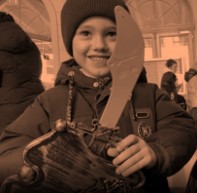I always figured kids had a pretty easy time of it during war.
Thanks to TV2 News, my eyes have been opened.
A kid’s-eye view of war: “It’s all Putin’s fault”
Sofie Synnøve Herschend & Alexander Østerlin Koch, TV2 News, Mar 19
Herschend & Koch are only writing about one particular set of children whose experiences are limited to one particular war, so we probably need additional research to know whether their findings are representative of all children in all wars. We shouldn’t jump to any big conclusions. But with that caveat aside, it’s an enlightening piece.
A lot of women have fled Ukraine to Poland with their children to get them out of harm’s way. We’ve all seen that in the news, of course, but it had never occurred to me that those adorable little ragamuffins weren’t enjoying themselves.
Herschend and Koch seemed to anticipate my ignorance, and their article seems custom-tailored to fill the gaps in my understanding:
But how do children experience the violent war that the adults are now fighting? With their parents’ permission, TV2 has questioned 10 Ukrainian children in Poland, shortly after they escaped the bombs in Ukraine.
If you’re like me, you’re probably expecting that the children’s accounts would be largely positive. No school, no bedtime, and all the excitement of the explosions. What’s not to like?
Well, you’re in for a couple of surprises. First, a lot of these kids seem to have a pretty negative view of the war. Second, and this is the real shocker, they’re not very bright.
Some of them are downright stupid.
Again: this is all anecdotal, so we shouldn’t generalize. I don’t mean to suggest that Ukrainian children are inherently any more or less intelligent than Danish or American children; only that the samples selected by Herschend and Koch cannot possibly be the best and the brightest a nation of 44 million has to offer.
Possibly that’s because the smarter Ukrainian children have been left behind to help defend the homeland: the journalists conducted their interviews at a railway station in Przemysl, the first Polish stop on the line from Ukraine, and at a Red Cross emergency station in the border town of Medyka.
The authors give us a lot of background on where these kids came from and what they’ve been through but the whole point of the article is to help us understand the war from the kids’ perspective: I translated the title of the piece colloquially (“a kid’s-eye view of war”), but a literal translation would be “war at child height.”
Six-year-old Misha, a little boy from Kharkiv, holds up his plastic sword and shield and tells the journalists, “I have packed my shield and my sword so that I can defend myself.”
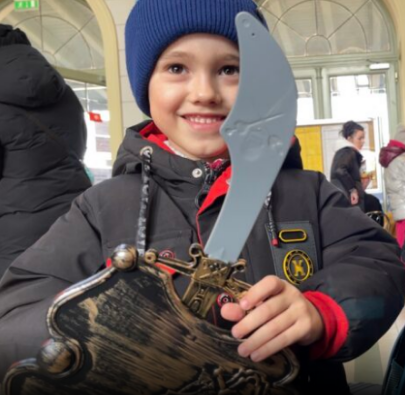
Misha’s bravery is laudable, but bravery without good sense is just recklessness. Does Misha believe his plastic shield is going to stop a bullet? Will it deflect the searing flames or protect him from the percussive force of explosive ordnance? Are there no adults on hand to tell him that his little plastic scimitar couldn’t even cut through a Russian infantryman’s cotton uniform, much less flesh and bone?
His smile suggests a highly unrealistic view of his preparedness.
But little Misha is hardly the stupidest of the children interviewed.
Jeva, for example, is also six.
“I have a favorite toy I brought along,” she says. “My bunny. I didn’t pack anything else. Just him.”
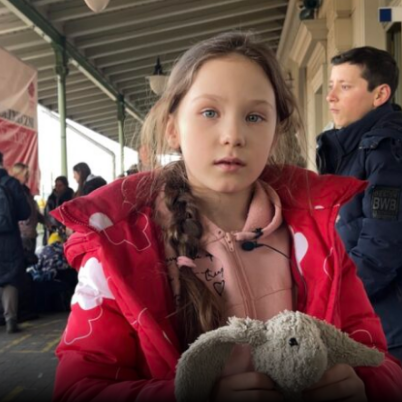
Her expression suggests that the mere act of articulating her strategy may have revealed shortcomings she hadn’t considered before.
Her decision would be understandable if the bunny were her only possession, but she says she took her favorite toy, which implies the existence of others. We can’t know what those toys were (the authors don’t even ask her), but while I’m not fool enough to think a child of six would have firearms, even in Ukraine, is it so crazy to think she might have had a Swiss army knife, a first-aid kit, a canteen? Her choice of a stuffed toy bunny makes Misha’s plastic sword and shield seem like the height of prudence in comparison.
Here are the sisters Yana and Masha:
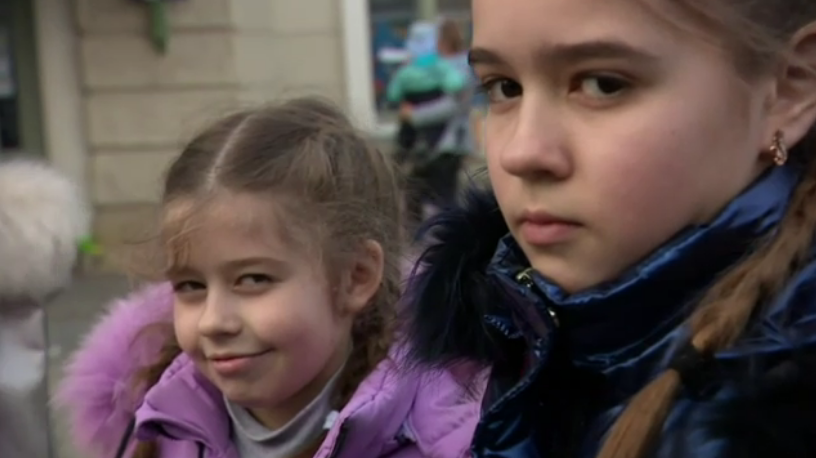
Yana, on the left, is seven years old. Masha is twelve.
Masha says:
We were at home when we heard some explosions and then we ran down to the basement. When we got up from there, they bombed again. So we just ran up and down. Up and down. I was very scared. Not for myself, but for my sister, for she is very small and does not understand any of it.
After Misha and Jeva, Masha seems quite sage—but then, she’s twice their age, so that’s to be expected.
It’s entirely rational to go into the basement when there are explosions nearby, and it’s just as rational to go back upstairs when the bombing stops. One can easily imagine a situation in which a family would be going up and down the basement stairs quite a lot during a period of sustained shelling. And I suppose it would be frightening to do all that in the company of a younger sibling bereft of understanding.
And let there be no doubt: Yana is bereft of understanding. She hasn’t got an ounce of sense. She tells the journalist what she brought down to the basement as they sheltered from the bombs:
“I took two little dwarves and a little doll, and then I took a little pig and a rabbit in my pocket.”
Bombs were bursting all around them and Yana chose to gird herself with a couple of dwarves, a doll, a pig, and a rabbit.
This is why children are not often consulted on military strategy.
It’s interesting, by the way, that 20% of the subjects interviewed equipped themselves with toy rabbits. Is there some Ukrainian tradition or folklore to explain this? A Ukrainian version of Holger Danske, for example, in which the slumbering hero is not a stout warrior but a fluffy bunny?
The authors inform us that when Masha and Yana were brought to Odessa for shelter, only to find themselves under still more bombing, Yana recalls: “I was wildly scared, and asked my mother: ‘what’s going on now?’ “
A reasonable question: we might surmise that the experience of traveling from their home in the Donbas region to Odessa had smartened the girl up. We would be wrong:
“…but I did not understand what she was answering.”
Awareness of our own ignorance is the first step on the road to enlightenment, so despite her atrocious ignorance this might actually represent an important breakthrough for Yana.
And then there’s eight-year-old Iryna.
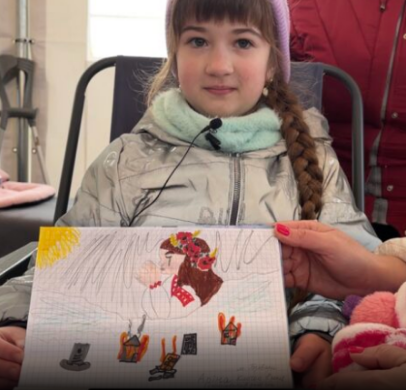
“artwork” by Iryna
When a rocket struck close to her home, she says, “Then I really felt that we were in danger.”
A creditable observation.
“We took a holy picture and hugged it, hoping for the best.”
A girl who is sensible enough to understand that rockets striking close to her home represent danger ought to be sensible enough to realize that holy pictures are an inadequate line of defense against projectile ordnance.
If we needed any further proof of her lack of intelligence, Iryna also says: “I miss my animals because I left my hamster and my fish at home and I’m really worried about them.”
(What, no bunny rabbit?)
The article implies that Iryna and her brother, mother, and grandmother fled their home (in a suburb of Kiev) on foot. Whether or not they walked all the way to Poland, it’s obvious that many days had passed since their departure. It will clearly be quite a long time before they return—if they return. Her hamster and fish will be dead by then because she made no arrangements for a neighbor to feed them in her absence. It’s not Russian weapons that will have killed them, but her own thoughtlessness.
Here’s her eight-year-old brother Nikita:
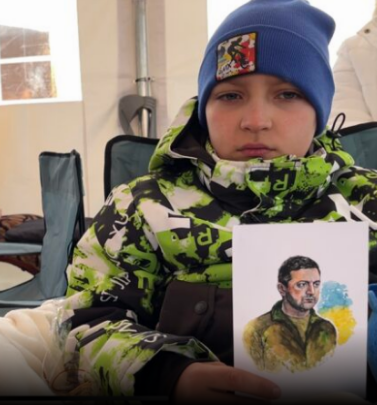
artwork clearly not by Iryna
“Our president is my hero,” Nikita says, “and he will never allow Ukraine to lose. I hope he visits us at home in Irpin when the war is over so I can meet him.”
Nikita is clearly caught up in war hysteria. The way things are going it’s unlikely there’ll be much of Irpin left when the smoke clears, and his hero-worship is troubling.
Then there’s six-year-old Sofia.
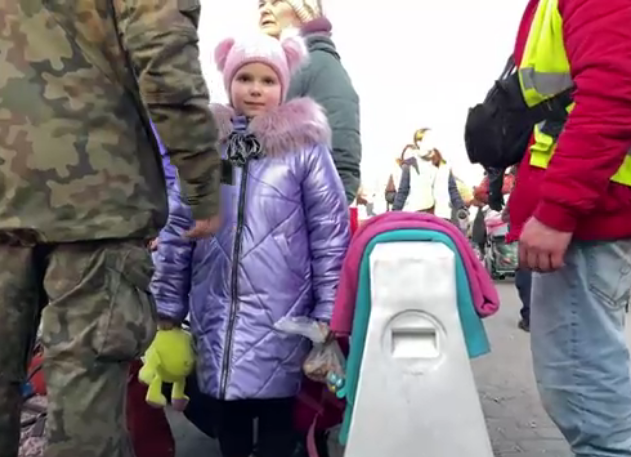
She says “It’s all Putin’s fault.”
This is certainly true, but one can’t help wondering how Sofia came by that information. Isn’t she most likely just parroting what she’s heard from the adults around her? Is that prudent in wartime? Isn’t that how rumors get started? Isn’t that making her vulnerable to misinformation?
Also, the authors don’t mention it but she appears to be holding a plush toy of Mike Wazowski from Monsters, Inc. Presumably this is a treasured possession she brought along on the arduous flight from her distant home.
Bunny rabbits. Plastic shields and swords. Disney merchandise. With their worlds burning around them, these are the items children value, for a very simple reason:
Children are stupid.
All children, everywhere, including the prodigies who speak eight languages and can break down quadrilateral equations in kindergarten.
It’s not their fault. They won’t always be stupid—not all of them. They’re stupid because they don’t know anything.
Not only are they stupid, but they aren’t very good at things. Certainly they can be trained to manage simple tasks, but you’ll never get them to tune up your engine or file your taxes.
All of this stupidity is the product of innocence, which is wonderful but also extremely dangerous.
We inherit a cultural legacy that suggests we can learn from the innocence of children, which in fact we can—but we’ve corrupted it by pretending that children themselves are wise. They’re not.
They’re idiots.
So while it’s healthy and positive to try and see the wonder (and horror) of the world through the eyes of a child—that is, to see it with fresh eyes and an unjaded soul—trying to understand the world through the eyes of a child is a fool’s errand.
And yet this idea that children can offer understanding of our world, rather than an innocent way of looking it, is something that the left has embraced for decades.
Leftists routinely trot out the “wisdom” of children in support of their political positions, as though ignorance and illiteracy conveyed some kind of sacred authority.
Is that sane?
“You may disagree with me, but just try contradicting this seven-year-old,” isn’t the kind of reasoning that advances one’s argument.
Kids do sometimes utter striking phrases. (A favorite of my own from when Youngest was still a toddler: “Isn’t it fun to be people?”) But so would a computer programmed to pull words out of a dictionary and randomly arrange them into sentences. Sooner or later, something wise or clever would emerge. It’s like the hypothetical million monkeys typing for a million years: they may indeed eventually write Hamlet—but only by accident, and without any idea that they’d done it, and with billions of pages of random nonsense generated in the process.
Our leftist elites even went so far as to invite an uneducated and deeply troubled child (Greta Thunberg) to address a gathering of world leaders. For what purpose? What unique knowledge did that sad and broken child have to offer? She snarled at and harassed them, which was unseemly of her but richly deserved by them.
This TV2 article never tells us why they thought it would be useful or helpful to find out how children experience the war. My own best guess is that they wanted to stir their readers’ emotions. Despite the text above, my emotions were indeed stirred. How could they not be? These innocent children have walked through the fires of Hell.
The stirring of emotions is not the role of journalism, however, but of propaganda.
Possibly this is helpful propaganda. Maybe there are Danes who felt ambivalent about Ukraine but will after reading this article become moved to compassion.
But to what end? To open their hearts to Ukrainians against whom their hearts had previously been hardened? To adopt a Ukrainian family? To send money to the organizations helping them? To take up arms? To toss the Russian dressing from their pantry?
This article is hardly the only example of propaganda to be found in Danish or American media. It’s hard to find articles about the war that aren’t propaganda.
Propaganda has its uses, but also its dangers. Propaganda acts on emotions rather than reason and emotions can lead a people to some frightful places. The propaganda bombarding Russians just as thoroughly as the rockets bombarding Ukrainians is a useful reminder of the ends to which propaganda can be applied.
It would be catastrophic if western propaganda took such hold of the western population that we were driven into a full-scale war between nuclear powers. So take note of what’s happening: emotions are being manipulated to rally support for Ukraine, and that increasing support for Ukraine is engendering some very martial responses in some quarters as elected officials seek to capitalize on it: there are already American legislators calling for a more muscular intervention.
Maybe that’s the right call. Maybe it’s not. But a time of war is not a time to be ruled by emotion.
(I would make the case that it’s never a good thing to be ruled by emotion, but that’s an argument for another day.)
When a nation invades another and seeks to conquer it by force of arms, everyone suffers—including children. Shining a spotlight on those poor innocents achieves no useful end: anyone who didn’t already know the children of Ukraine were suffering as a consequence of the war is probably beyond reach anyway.
“I’m really worried about Odessa,” says the twelve-year-old Masha, “but I’m also worried about the whole of Ukraine, and all the countries that are going to suffer under this. I hope for all the countries of the world that World War III does not break out, that we get rid of the President of Russia, and that all countries can be friends.”
Her little sister Yana agrees: “I hope that everything will work out so that both Russia and Ukraine can live happily and peacefully to the end of their days.”
Sweet sentiments, but if we keep pumping up our emotions things are almost certain to get far worse for far more children.
Even the bright ones.
